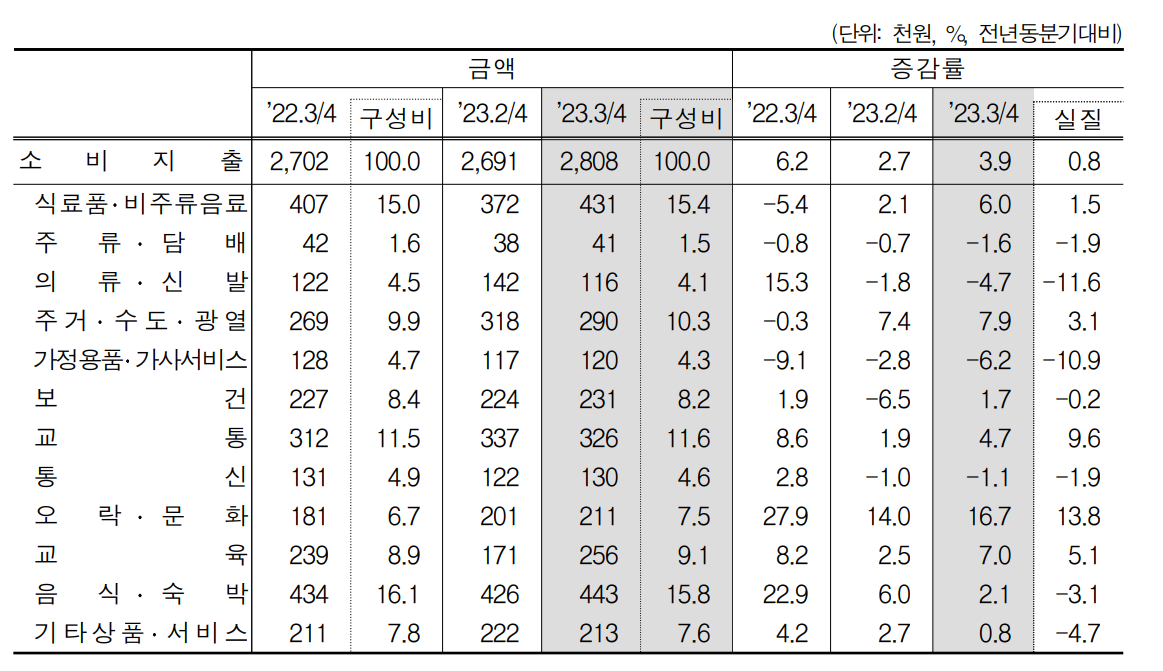

登錄


登錄
海擇短評 Haize Comment:
近期韓國統計局公佈了"2023年第三季家庭消費趨勢調查",從家庭消費在各類項目的增減趨勢來看,可以發現與美日官方/投行所公告數據的趨勢大體一致-亦即,當薪資增速比不過通膨增速,而且落差巨大,實質所得陷入高度負增長之際,家庭在消費上的分配並非僅集中在剛性支出,旅遊及餐飲這類"小確幸"式消費的佔比與增速也不小。
該數據顯示,2023年第三季韓國每戶(家庭)平均月消費為280.8萬韓元(約2,100美元),相對去年同期相比成長了3.9%。分解來看,在通膨增長的背景下,房/水/電/天然氣消費的年增速為7.9%,約為整體消費增速翻倍;而非必要支出除了娛樂、餐飲、教育這三類,大體消費增速都跟不上平均增速,特別是服裝/鞋類與家庭用品/家庭服務這兩類消費,不但沒有維持與收入相同的增速,反而出現減速,分別為(-4.7%)與(-6.2%)。
值得注意的是,從與旅遊相關的消費類別來看,娛樂文化的月消費為21.1萬韓元、年增速16.7%,為所有類別中最高,佔整體支出的7.5%;再看分解數據,娛樂文化包括跟團旅遊、活動體驗、影音、運動、文化設施、書籍為主;其中,國內與國際的跟團遊消費增幅最高,較去年同期成長150.5%;而在交通類別中,機票和船票消費則增長了45.7%。
此外,家庭每月平均消費支出中,佔比最大的類別是餐飲和住宿,佔比為15.8%,與雜貨和非酒精飲料相當(15.4%);比較特別的是,在餐飲和住宿的消費中,94.6%的消費屬於餐飲消費,住宿消費僅佔5.4%。
除了整體的平均月消費,官方數據也顯示了不同收入族群間的消費差異,其中差距最大的是交通運輸類別的消費。韓國整體家庭在交通運輸類別的平均月消費為32.6萬韓元,而收入最低的20%家庭,平均月消費為7.7萬韓元;相比來看,收入最高的20%家庭,平均月消費為62.6萬韓元,約為收入最低家庭的9倍,細分看主要差距在機票和船票的消費。
----------
The recent "2023 Q3 Household Consumption Trends Survey" released by the Korean Statistical Bureau shows trends in various categories of household spending consistent with official and investment bank data from the U.S. and Japan. When wage growth lags behind inflation, real income declines. However, household spending is not solely focused on essential expenditures. The share and growth of discretionary spending, such as travel and dining, termed "small but certain happiness," are also notable.
The data reveals that in Q3 2023, the average monthly household consumption in Korea was 2.8 million KRW (approximately $2,100), a 3.9% increase from the same period last year. Against the backdrop of inflation, the annual growth rate for housing, water, electricity, and gas consumption was 7.9%, about double the overall consumption growth rate. For discretionary spending, except for entertainment, dining, and education, the overall growth rate in most categories did not keep up with the average increase. Particularly, clothing/shoes and household goods/services experienced a slowdown, with respective growth rates of (-4.7%) and (-6.2%).
Notably, in travel-related spending, entertainment and culture had the highest annual growth rate of 16.7% at 211,000 KRW per month, accounting for 7.5% of total expenses. This category includes group tours, experiences/activities, multimedia, sports, cultural facilities, and books. Group tours, both domestic and international, saw the highest increase, growing 150.5% from the previous year. In transportation, airfare and boat ticket expenses grew by 45.7%.
Furthermore, the largest share of monthly household expenditure is on dining and accommodation, accounting for 15.8%, comparable to groceries and non-alcoholic beverages (15.4%). Interestingly, within dining and accommodation expenses, 94.6% is attributed to dining, with only 5.4% for accommodation.
The official data highlighted consumption disparities among different income groups, with the largest gap in transportation. The average monthly transportation spending for Korean households was 326,000 KRW, the bottom 20% of income earners spent an average of 77,000 KRW per month, while the top 20% of earners spent 626,000 KRW per month on transportation, about 9 times more than the lowest earners, with the main difference being in airfare and boat ticket expenses.
----------
통계청이 발표한 ‘2023년 3/4분기 가계동향조사’ 결과는 미국과 일본의 공식 및 투자은행들이 발표한 수치와 대체로 일치한다. 임금 인상이 인플레이션에 뒤처지면 실질소득이 떨어진다는 것이다. 그러나 가계 지출은 기본 지출에만 집중되는 것이 아니다. 여행과 음식 같은 '작하지만 확실한 행복'식 소비의 비중과 성장률도 증가하고 있다.
2023년 3/4분기 가구당 월평균 소비지출은 280만8,000원으로 집계됐다. 이는 전년동기대비 3.9% 증가한 것으로 나타났다. 인플레이션 상황에서 주택, 물, 전기, 가스 소비의 연간 증가율은 7.9%로 전체 소비 증가율의 두 배가량이다. 자유롭게 지배할 수 있는 소비에서 오락, 음식, 교육을 제외한 대부분의 소비 항목의 전체 성장률은 평균 성장률을 따라가지 못한다. 특히 의류·신발 및 가정용품·가사서비스의 증가폭이 둔화되어 각각 (-4.7%) 및 (-6.2%) 를 기록했다.
특히 여행 관련 소비 가운데 오락문화 소비가 월 21만1,000원으로 연간 증가율이 16.7%로 가장 높아 전체 소비의 7.5%를 차지했다. 오락·문화의 내역에는 영상·음향기기, 악기, 취미용품, 운동, 문화시설, 서적 등이 포함되어 있다. 국내와 국제 단체관광은 전년동기대비 150.5% 증가해 가장 빠르게 증가했다. 교통 부문에는 항공, 선박 이용료가 45.7% 증가했다.
가구당 월평균 소비지출 부문 중 가장 많은 비중을 차지한 부문은 음식·숙박(15.8%)이다. 이는 식료품·비주류음료(15.4%)와 맞먹는 수준이다. 흥미롭게도 음식·숙박비 가운데 94.6%는 음식에, 5.4%만 숙박에 썼다.
공식수치는 부동한 소득군체간의 소비차이를 강조했는데 그중 교통 부문의 격차가 가장 컸다. 한국 가구의 월평균 교통비 지출은 32만6,000원, 소득이 가장 낮은 20% 가구의 월평균 교통비 지출은 7만7,000원, 소득이 가장 높은 20% 가구의 월평균 교통비 지출은 62만6,000원으로 소득이 가장 낮은 가구의 9배가량으로 주로 항공·선박 이용료었다.

文章鏈接 Hyperlink:https://www.traveltimes.co.kr/news/articleView.html?idxno=407026
資料來源 Resource:Travetimes
標籤 Label: Korea Consumption Travel